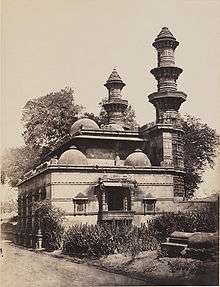Muhafiz Khan Mosque
| Muhafiz Khan's Mosque | |
|---|---|
 Muhafiz Khan's Mosque, 1855 | |
 Location in Gujarat, India | |
| Basic information | |
| Location | Ahmedabad |
| Geographic coordinates | 23°01′04″N 72°35′21″E / 23.0177778°N 72.5891667°ECoordinates: 23°01′04″N 72°35′21″E / 23.0177778°N 72.5891667°E |
| Affiliation | Islam |
| Municipality | Ahmedabad Municipal Corporation |
| State | Gujarat |
| Status | Active |
| Architectural description | |
| Architectural type | Mosque |
| Architectural style | Indo-Islamic architecture |
| Founder | Jamal-ud-din Muhafiz Khan |
| Completed | 1465 |
| Length | 51ft |
| Width | 36ft |
| Minaret height | 55ft |
| Designated as NHL |
National Monument of Importance ASI Monument No. N-GJ-26 |
.jpg)
The Muhafiz Khan Mosque is a fifteenth-century mosque located in the city of Ahmedabad in the Indian state of Gujarat. It is considered to be one of the more exceptional structures in the city.[1][2] The mosque was constructed in 1465 by Jamail-ud-Din Muhafiz Khan during the reign of Mahmud Shah I (1458-1511), and is considered to be an excellent example of Mughal architecture.[3] It is named for the governor of the region at that time. The mosque is a protected building under the auspices of the Archaeological Survey of India.
The façade of the mosque has three arched entrances and a richly carved minaret at either end. The design has similarities with the Isanpur mosque and introduced a new architectural style to Ahmedabad.[4][5] It measures 51 feet (16 m) by 36 feet (11 m). The minarets stand 50 feet (15 m) high.[6] Alexander Forbes had replicas of the mosque made from wood and returned to England c 1880-1885, they now reside at the Victoria and Albert Museum in London.[7][8]
During the communal violence in 2002, the mosque was extensively damaged. Afzal Khan said that rioters damaged intricate carvings on the southern elevations of the building and that the damage to be irreparable.[9] This damage has caused upset among India's Muslim population. The restoration of shrines and mosques was debated extensively in parliament[10] The Indian History Congress(IHC) has requested that the Archaeological Survey of India restore and rebuild all religious structures. Ramakrishna Chatterjee, stated to the IHC that the mosques of Muhafiz Khan, the tomb of Wali Mohammed Wali and the mosque of Malik Asin had been damaged or destroyed.[11] By 2006 restoration work had been completed and the mosque reopened to the public.[3]
Gallery
 Near view
Near view North minaret
North minaret Niche of the southern minaret
Niche of the southern minaret Summit of a minaret
Summit of a minaret Niche in centre of the base of southern minaret
Niche in centre of the base of southern minaret Mosque from distance, 1866
Mosque from distance, 1866 Niche of the lower part of the southern minaret
Niche of the lower part of the southern minaret Base of south minaret
Base of south minaret
References
- ↑ Manohar Sajnani (2001). Encyclopaedia of Tourism Resources in India. Gyan Publishing House. p. 105. ISBN 978-81-7835-018-9.
- ↑ Prakash, Om (2004). Cultural History Of India. New Age International. p. 196. ISBN 978-8122415872.
- 1 2 TI, P (6 March 2006). "ASI to restore monuments damaged in Gujarat riots". Times of India.
- ↑ Places, Visiting. "Visiting Places". Kendriya Vidyalaya - Ahmedabad Cantt. Government Of India.
- ↑ Library Board, The British. "North-east corner of Muhafiz Khan's Mosque, showing sculptural detail at base of minaret, and side arch, Ahmadabad 1720". The British Library Board.
- ↑ Caine, W. S. (1890). Picturesque india. Routledge. p. 52.
- ↑ Yagnik, Achyut; Suchitra Sheth (2011). Ahmedabad: From Royal city to Megacity. Penguin. ASIN B008RY1MJY.
- ↑ Gazetteer of the Bombay Presidency: Ahmedabad. Government Central Press. 1879. p. 279.
- ↑ Engineer, Asgharali (2003). The Gujarat Carnage. Orient Blackswan. p. 389. ISBN 978-8125024965.
- ↑ NN, T (23 July 2002). "Demolished shrines issue to come up in Parliament". Times of India.
- ↑ Correspondent, Special (21 March 2002). "ASI urged to rebuild monuments". The Hindu.